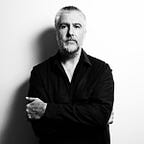Neural Networks & My Journey Into Nascent Space
From Pap-smears to GANs
In 1992, three years after I first identified as an artist, I became aware of the alarming false-negative rate (FNR) that top cytology laboratories in America were experiencing while examining Pap-smear specimens for cervical intraepithelial neoplasia (CIN), cervical cancer.
The FNR was as high as 35% at some labs which meant there were tens of thousands of women unaware of their condition due to misinterpreted Pap results. The false-negatives were a result of human error due to the inability of lab technologists to discern between normal and abnormal specimens. Taken aback by the severity of this reality, I set out to learn what the morphological abnormalities of a Pap-specimen looked like under a microscope. I learned for instance, that the ratio of the size of a nucleus to its cell and the density of the nucleus were indicators of the health of a cell. A cancerous cell for example might have an irregular shape or unusually large and darker nucleus.
At this point I knew that a lab tech’s ability to discern the “abnormality threshold” of a specimen could be improved upon by machine. With a rudimentary understanding of ruled-based machine learning, or “fuzzy-logic,” I set upon gaining access to as many Pap specimen slides as possible and with the assistance of cutting edge microscopy, a NeXT computer gifted to me by none other than Steve Jobs and a Sun Microsystems Sparc workstation, also donated, I embarked upon my first efforts into the world of computer-vision. (Hat tip to my dear friend and neuroscientist Marco Versace who introduced me to the concept of neural nets, unsupervised learning and back-propagation)
What I had hoped would end with the saving of countless lives would never be — An earthquake, the Northridge Earthquake in Southern California, destroyed the more than 30,000 specimen slides that comprised my training data. I was never able to get back on track. I did, however, manage to make some art from the data. This was my first foray into generative art.
From 1990–2010 my work as an artist primarily leveraged traditional photographic methods. The transition from film to digital came suddenly and I had a vested interest in both understanding this emerging technology as well as pushing the limits of what CCD and CMOS sensors were capable of and how DSP (digital signal processing) could raise the stakes.
I realized that camera manufacturers were throttling the capabilities of the components inside their cameras. The “crippling’ of their own products might have seemed counterintuitive at first, but whether it was a function of keeping another product in their lineup from becoming obsolete or managing the power demands of more robust processing to save on battery life, I had to find workarounds to get the most I could from both still and video cameras. In some cases, hacking firmware was an option and in others, what was called for was a camera teardown and a soldering iron at the ready.
Call it hacking, tweaking or merely trying to understand the why before understanding the how, my practice as an artist has only deepened my relationship with science and technology. Working with technological and generative methods like machine-learning and blockchain assist me in my understanding of identity and value.
When Ian Goodfellow published his paper on Generative Adverserial Networks (GAN’s) in 2014, I was excited to see if I could train such an algorithm on my own photographic images to produce synthetic Kevin Abosch photographs. With advances in GAN technology and important contributions from people like Martin Arjovsky, Soumith Chintala, Léon Bottou, Alec Radford, Luke Metz, Tero Karras, Samuli Laine, Timo Aila and many others, the landscape of generative art has taken a notable leap forward.
The scientific method moves from a hypothesis to an experiment and ultimately yields a result. It’s understandable that scientists and technologists are result-driven. It is the result that yields the empirical data that speaks to an experiment’s success and failure. Indeed, the very reputation of the scientist and the technologist is a function of presenting results to their peers. My own interest in the scientific method has waned over the years. Empirical data can be of great practical use, but as an artist I’m more interested in process, ritual and insights gleaned long before the result.
With respect to deep-learning algorithms, I force complications by limiting and corrupting the input data. What would ordinarily comprise the latent space is sublimated into what I call “nascent space.” Nascent space exists within a gaussian, or normal distribution of data but holds the prima materia from which discovery and creation are born. It is in this nascent space that I find truths not necessarily apparent within results. — Kevin Abosch
This text is an excerpt from my upcoming book “Nascent Space 2019–2020”
Instagram: http://instagram.com/kevinabosch
